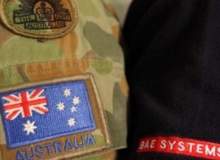*Edit*
This whole def'n issue was bugging me so today I spoke with a few senior colleagues (I work in the RCN) about their take on the definition of Aegis. The best was that Aegis is both the radar and the CMS. They work hand in glove with each other. One can have Aegis CMS and a different radar, and Aegis radar and different CMS. They were originally developed together (
US Navy Factfile). Paul Lemmo was likely using Aegis as a shorthand for the capabilities of the system, without going into the minutia detail. So I'm right and wrong?? *shrug, steps off high horse*
Aegis use to be clearly identifiable thing, the USN used it, and it was fairly uniform. However, now its much more modular its not as clear cut any more. Saying Aegis is like saying 5th generation fighter, its now effectively a marketing term, and no longer really ties together all the capabilities like it used to. I see CMS330 as a component derived from Aegis. CMS330 isn't the magic key, by itself it doesn't bring a whole lot to the table.
If Lockheed says anything that has CMS330 is aegis, then the Aegis brand has fallen quite a way, and NZ in now an Aegis navy.
The radar used to be very tightly integrated into Aegis, but that is no longer the case. CMS330 advantage is that it is supposed to be fairly easy to integrate other aegis components into it.
I find Australia is a very interesting example what it is doing with its Hobart class. Its going to junk out its entire rather new Aegis set (radar, consoles, C&D, WCS, etc) and replace it with newer versions of Aegis and the 9LV system (which will be the consoles), its own unique powerful radar, but still firing US weapons etc. I find it quite curious that such a new user of Aegis has decided to junk a lot of the previous strong points (radar, consoles, displays), and really focus on keeping the core aegis system (which is the newer baseline C&D,WCS, and I assume some sort of adapted FCS but operating through different illumination..), selection high capability additions like CEC, but replacing a lot of its outer portions, it then starts to become very blurred. They clearly aren't doing this to save money (they already have the equipment installed) and clearly the ships won't be any less capable. The fact they are putting CEC on every ship also seems to indicate they foresee no issues tightly integrating with US and other aegis fleets.
edit to provide sources:
References regarding upgrade:
This includes mandating a Saab Australia combat management system on the upcoming Offshore Patrol Vessels, which will be built in Australia from 2018, and an Australian tactical interface developed by SAAB Australia for the Hobart class Air Warfare Destroyers when their Aegis combat management system is upgraded in the future, consistent with the 2016 Defence White Paper.
Aegis for Future Frigates with Saab tactical interface

www.australiandefence.com.au
Three 483ft-long Hobart-class destroyers are planned for the Australian Navy with keels already laid for the lead vessel Hobart and second vessel Brisbane. The destroyers will be fitted with a number of advanced systems including the Australia-developed active phased array radar CEAFAR
Australia’s troubled shipbuilding industry could be overhauled under radical proposals by the Canberra government, local media reports have indicated. Speculation is rife that British defence giant BAE Systems will be brought in to rescue the Navy’s long-delayed and over-budget Hobart-class air...

www.naval-technology.com
Also under SEA 4000 Phase 5b.. there are better and newer info on this, but I can't seem to find it right now.
There is some interesting points regarding this on the hunter -
A BIGGER SHIELD – Aegis Baseline 9 for Australia – ADBR
But that highlights the modularity of the system in place now. Not all US equipment and configuration is ideal for other nations. Its not just about less capability or saving money either.
Aegis is now more like the software (it no longer needs special military hardware, regular COTS servers run it) and is really the development API for warships. More like how DirectX or OpenGL is API. Vendors then develop solution that integrate and interface their hardware with those API libraries.
We will probably see Aegis scale up into new high capability platforms, and scale down to smaller ships and platforms. And possibly into different ships other than surface combatants.



